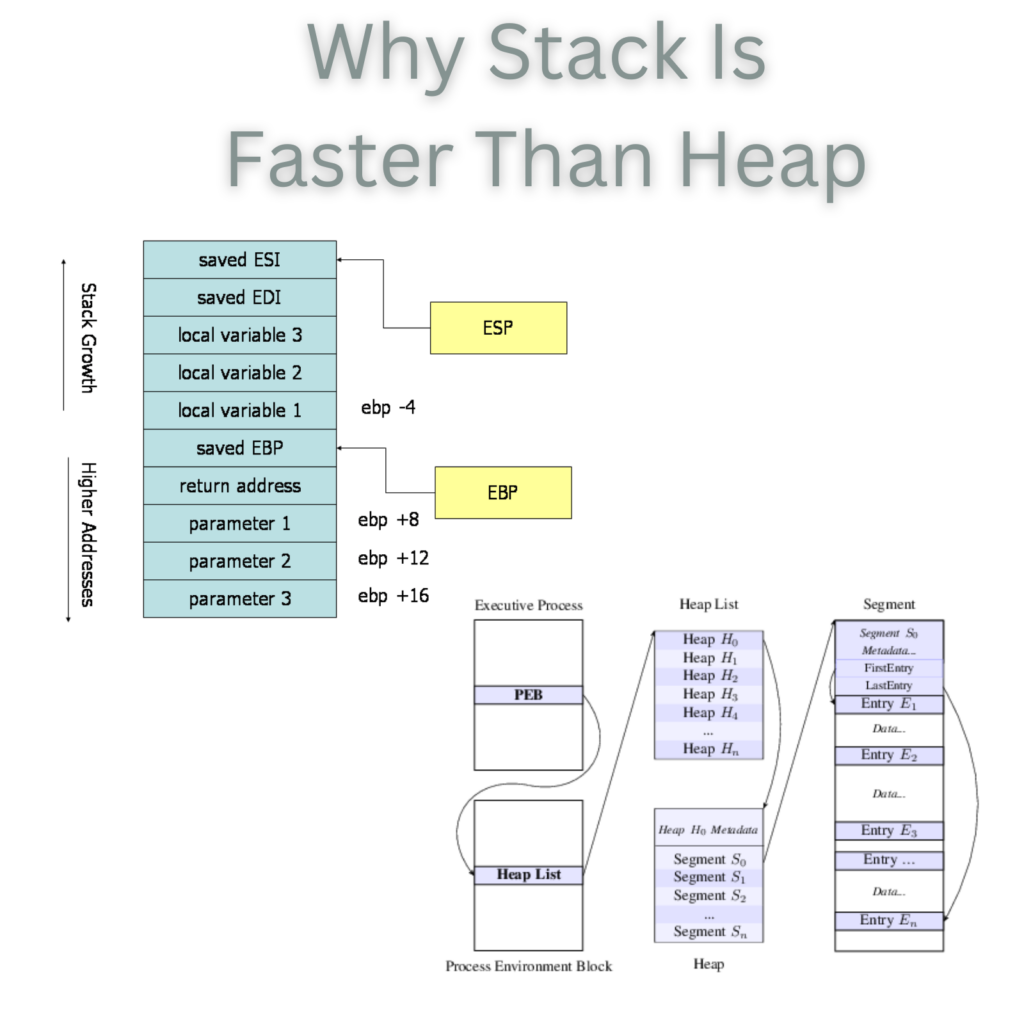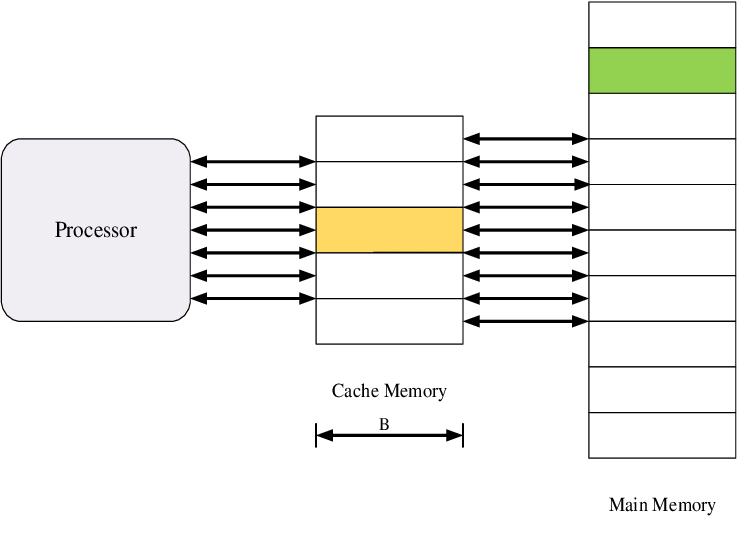Introduction

Today I will cover why stack is faster than heap. The main reason is that memory is allocated and deallocated much more efficiently due to the the simplicity of the algorithm. When an item is added to the stack, it is simply added to the top of the stack in constant time, O(1). Similarly, when an item is removed from the stack, it is removed from the top of the stack in constant time, O(1). This makes the stack a very efficient data structure for storing and accessing data.
On the other hand, the heap is a more complex data structure and requires more overhead to manage. When an item is added to the heap, the heap must be adjusted to maintain its specific properties, such as being a complete binary tree. This can take longer than simply adding an item to the stack. Similarly, when an item is removed from the heap, the heap must be adjusted again, which can also take longer than simply removing an item from the stack.
Additionally items are added and removed, the stack and the heap have different memory allocation strategies. The stack is typically allocated in the program’s memory space, which is typically much smaller and faster to access than the system’s memory space where the heap is located. This can also make the stack faster to access than the heap.
The stack is faster than the heap because it is simpler and more efficient in both its memory allocation and its management of data. In the next section I’m going to go over some examples of this in a low level programming language such as C/C++.
Code Examples In C
Below I have a few examples of how the stack and the heap work in C, and why it is faster than the heap in certain situations.
First, here is an example of how to allocate memory on the stack in C:
int main() {
int variable_in_stack = 13;
return 0;
}
In this example, the variable_in_stack is allocated on the stack. This means that when the main function is called, space is reserved on the stack for the variable_in_stack and its value is set to 5. When the main function returns, the space on the stack that was reserved for the variable_in_stack is automatically freed, and the variable_in_stack is no longer accessible.
Now, here is an example of how to allocate memory on the heap in C:
int main() {
int *variable_in_heap = (int *)malloc(sizeof(int));
*variable_in_heap = 13; // this does a single 8bit allocation
free(variable_in_heap);
return 0;
}
In this example, the variable_in_heap is allocated on the heap using the malloc function. This means that when the main function is called, space is reserved on the heap for the variable_in_heap and its value is set to 5. Unlike the stack, the memory allocated on the heap is not automatically freed when the main function returns. Instead, the programmer must explicitly call the free function to free the memory on the heap that was allocated for the variable_in_heap.
As you can see, allocating memory on the heap requires more overhead than allocating memory on the stack. This is because the heap is a more complex data structure than the stack, and requires more work to manage. In addition, the heap is typically located in the system’s memory space, which is typically slower to access than the program’s memory space where the stack is located. This can also make the heap slower to access than the stack due to the extra intricacies involved which I will cover in more detail below.
Windows Stack And Heap Differences
The stack and the heap are implemented differently in Windows and other operating systems, but the overall principles on how they work are more over the same. In general, the stack is faster than the heap because memory is allocated and deallocated much more efficiently on the stack as we discussed earlier in the article but there’s more to it than that.
In Windows, the stack is typically implemented as a contiguous block of memory that is managed by the operating system. When a function is called, space on the stack is reserved for the function’s local variables and parameters. This space is automatically freed when the function returns, so there is no need for the programmer to explicitly free the memory on the stack.
In Windows, the stack and the heap are typically allocated in different memory spaces. The stack is typically allocated in the program’s memory space, which is typically much smaller and faster to access than the system’s memory space where the heap is located. This can also make the stack faster to access than the heap.
The above holds true for Windows but similar implementations exist for Linux and Mac. Obviously there’s more differences to it that are related to how the code is implemented which we will cover next.
Why Stack is Faster Than Heap Implementation Wise
As you can see below the stack and heap diagram can visualize indicate how much more complex one implementation is than the other. There are several layers involved in between but the simplicity of the stack is what makes it so fast. It does have off course disadvantages which are outside the scope of this article but when it comes to accessing data and speed you can rely on the stack being faster.
Below I will try to explain how implementing a stack is much easier and reliable on optimizing which results into faster execution when retrieving and storing data in stack. The stack and the heap are implemented differently in most programming languages and operating systems. In general, the stack is implemented as a contiguous block of memory that is managed automatically by the system, while the heap is implemented as a dynamic data structure that is managed by the programmer.
The stack is typically organized as a last-in, first-out (LIFO) data structure, where the most recently added item is the first one to be removed. This is because the stack is used to store the memory addresses of the functions and variables that are currently active in a program. When a function is called, the system automatically pushes the current address onto the stack, and when the function returns, the system automatically pops the address off the stack. This allows the system to keep track of which functions and variables are currently in use, and when they should be freed from memory.


The heap, on the other hand, is typically implemented as a dynamic data structure that can grow and shrink as needed. This is because the heap is used to store variables and data structures that are created dynamically at runtime, such as objects in object-oriented programming languages.
When a program needs to allocate memory on the heap, it must call a function such as malloc or new to request space from the system. The system then manages the allocation and deallocation of this memory, but the programmer must still explicitly call the free or delete function to free the memory on the heap.
The difference in implementation between the stack and the heap is that the stack is managed automatically by the system, while the heap is managed by the programmer. This means that a programmer must be careful to properly manage the heap to avoid memory leaks and other problems.
Caching Speed Access On Stack VS Heap
Caching can be used on both the stack and the heap, although it is more commonly used on the heap because the heap is used for dynamically allocated memory that is accessed globally. Caching on the heap can help to improve the performance of a computer by storing frequently accessed data in a faster storage medium, such as a CPU cache or RAM, so that it can be accessed more quickly.

In contrast, caching on the stack is not as common because the stack is used for storing local variables and function call information, which is typically accessed in a specific order and is not accessed as frequently as data on the heap. As we discussed earlier, the stack is organized in a LIFO (last in, first out) manner, so data that is added to the stack is accessed first, which makes caching on the stack less effective.
Caching can be used on both the stack and the heap, but it is more commonly used on the heap because the heap is used for dynamically allocated memory that is accessed globally. Caching on the heap can help to improve the performance of your code by storing frequently accessed data in a faster storage medium, such as a CPU cache or RAM.
Related
- The Future Of Programming
- Easy programming languages for beginners
- Does Hyperthreading Cause Latency